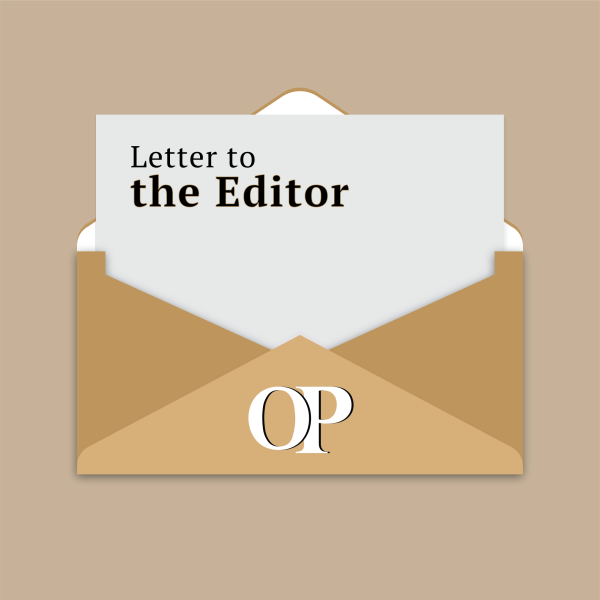Letter to the editor: Propaganda war: Debunking misinformation claims about Russia’s war in Ukraine

Walter Wolfsberger (left) and Professor Taras Oleksyk (right).
*This letter was prepared based on the most common questions received during Support Ukraine Table at Oakland Center last week.
We know that information is the ultimate power. In our times, this has become a common practice for interest groups to spread misinformation in order to shape attitudes of the populations and design favorable policy decisions. Often these are relatively harmless, others have very limited short-term effects. Normally, the longer the disinformation is out there, the more likely it is to get debunked, so artificial myths tend to vanish before they can cause any serious damage to society. The exceptions to this rule are not common, but they are happening at this very moment. We are witnessing the information war between Russia and Ukraine.
At this point the authors have no doubt that Ukraine will emerge victorious from this war, and it has a lot to thank for the support from the US and other democracies. The lack of reasonable justification of the invasion coupled with the lack of military success on the battlefield puts the aggressor in a difficult position. Frustrated with the difficulties of constructing a winner’s narrative, the Russian Federation is investing more and more into informational warfare.
The propaganda apparatus is steadily producing fakes, insinuations, click-baits and utter lies with frightening speed, all targeted to demonize Ukraine and justify the invasion. This is designed to slow critical decision-making, to make the outside world confused and hesitant about helping Ukraine, and to prolong the war. Since Russia has a larger military, Putin still believes that Ukrainian resistance can be broken by terrorizing civilians, forcing the government of Zelensky to opt for peace at any cost (search for “russian war crimes” to learn more).
Russia today is not a nation, because its people are not free citizens, they are governed by fear.
It is a corrupt power structure hungry to grab more land, increase its reach, to collect more wealth, to gain more power. There is no longer any free media, only an expensive propaganda machine that justifies the authoritarian regime, proven capable and willing to wage informational war disguised as press and social media. We have seen it all done before: disinformation campaigns during the 2016 US elections, the atrocious war in Syria, the annexation of Crimea and Donbass, the hybrid war in Central African Republic. This machine has the best information army their money can buy, they know how to do it, and we must be aware and vigilant about it.
Ukrainians have been on the front line of this war and experienced many of the tactics. Here, we would like to respond to the most viral products of Russian disinformation. The list is by no means exhaustive, and the tactics constantly change as they would in any other kind of war. Anything coming into your personal informational space must be assessed carefully. In addition to the information we provide, we encourage the readers to continue to do their own research and fact-checking.
Propaganda Claim #1. Ukraine government is illegitimate, it is a neo-nazi Junta after 2014, installed by the USA
The Revolution of Dignity in 2014 also known as the Maidan, was a result of people’s protests against the pro-Russian President Yanukovich’s refusal to sign a deal of association with the European Union, immediately after his meeting with president Putin in Moscow. The uprising started as a small student peaceful protest at the Independence square. This group of students was attacked and dispersed by the security forces with extreme violence. The videos of the beatings spread through the TV and social media prompting a huge national strike with millions of people across the country protesting the repressive actions. Once more, the government responded by escalating the violence, and passed extremely oppressive laws to limit public gatherings. As the situation escalated, protesters advanced towards the parliament but were fired on by snipers. Clashes between protesters and special riot police resulted in 108 protesters and 13 officers dead and many wounded. On the next day, Yanukovych fled the city and then the country. Later on the same day, the parliament impeached and removed him from office by constitutional majority (328 votes of the parliament’s 450 members). This came as a surprise to the US and the European countries who tried to broker a compromise power sharing agreement between the two sides during the protests.
After the old president was impeached and fled the country, the interim government organized the new election recognized by the international observers as legitimate. The new president, Petro Poroshenko received 54.7% of the votes cast. Meanwhile, Ukraine maintained the same parliament as before the revolution. Despite this, Russia claimed that the both interim government and President Poroshenko are illegitimate.
Five years later, Poroshenko lost the presidency to Volodymyr Zelensky. Following this new election, in 2019 there was a peaceful transition of power in Ukraine, demonstrating another hallmark of democracy. Despite the change, Ukraine continued the policy of European integration, according to the aspiration of its people. Frustrated with losing its influence, the Russian Federation once again claims that the Ukrainian government is illegitimate. This is accompanied by increasingly aggressive rhetoric repeating baseless claims that a “nazi junta” is illegitimately ruling Ukraine, and that president Zelensky, who is Jewish by descent, and whose family has suffered in Holocaust is himself a neonazi.
In contrast, there has been no real change of power in Russia, where Vladimir Putin has been at the head of the government since 1999.
Propaganda Claim #2. Russian language and russian-speakers were being genocided by Ukrainian government
Russia has repeatedly expressed concern about laws aimed at encouraging the use of Ukrainian language in Ukrainian government, media, and education. For example, the Ukrainian parliament approved the law that the majority of broadcast content (75% of national carriers and 50% of local carriers) should be in Ukrainian or translated into Ukrainian (closed captioning is often used). This policy is similar to the laws in the Baltics and other former USSR states, and is designed to encourage the use of the native languages that have been gradually, and often forcefully replaced by Russian during the Soviet period. This is often shown as evidence of “extremist nazification” of Ukrainie.
Despite the claims, no credible reports of any ethnic Russians or Russian speakers being under threat from the Ukrainian government have ever been produced. Majority of the people in the cities of southern and eastern Ukraine continue using Russian, and have never been banned from business and advertisement sectors or prosecuted by any means. In 2020 there were 125 Russian speaking schools in Ukraine at the secondary level. Almost a third of Ukrainian citizens speak mostly Russian, and most understand and can communicate in Russian fluently. Despite the large Ukrainian minority in Russia, the number of Ukrainian secondary schools there is zero.
There are, however, credible reports that in Russia-occupied Crimea and in the Donbas, Ukrainians face suppression of their culture and national identity and live in an environment of severe repression and fear. In Crimea, Russia forces Ukrainians to assume Russian citizenship or lose their property, their access to healthcare, and their jobs. Those who peacefully express opposition to Russia’s occupation or control face imprisonment on baseless grounds, police raids on their homes, officially sanctioned discrimination, and in some cases torture and other abuses. Religious and ethnic minorities are investigated and prosecuted as “extremists” and “terrorists.”
Propaganda Claim #3. The war is NATO’s fault. NATO is an aggressive alliance threatening Russia’s security, despite the promise never to expand to the east. Russia is preemptively defending itself, since the NATO forces are encroaching on Russia.
NATO is a defensive alliance, whose purpose is to protect its member states from the outside aggression against one of the members. Since its formation in 1949 NATO stayed loyal to their purpose, and never took part in a military offense. The NATO mechanism is not triggered when one of the NATO countries decides to engage in war outside of its territory, the latest example is Iraq War was fought between Iraq and a group of countries led by the United States and the United Kingdom, not NATO.
Since the fall of the Soviet Union, NATO enlargement was not directed against Russia, and it never promised to Russia not to admit new members. Every sovereign nation has the right to choose its own security arrangements and to enter into defensive regional alliances for purposes of self-defense. This is a fundamental principle of European security, reflected in the UN Charter, and is one that Russia has affirmed in myriad international and regional instruments such as the Helsinki Final Act.
Despite the propaganda claims, NATO does not encircle Russia – this is not even possible because of its size. Russia has land borders with 14 countries. Only five of them are NATO members (Norway, Poland, and the three Baltic states). Russia’s land border is huge, over 20,000 kilometers long, and only less than one-sixteenth of that (1,215 kilometers), is shared with NATO members, while 78% (or (15,566 km) of the Russian border is shared with either Kazakhstan, China or Mongolia.
NATO only deployed four multinational battlegroups to these NATO states as requested by the host nations and in response to Russia’s use of military force against Ukraine in 2014. Before Russia’s illegal seizure of Crimea and the war in Donbas, there were never any plans to deploy NATO troops to the eastern part of the alliance.
While baselessly accusing NATO of eastward expansion, over the last 30 years the Russian Federation violated borders of other countries and waged wars multiple times occupying parts of Moldova (Transnistria), Georgia (Abkhazia and Ossetia), and Ukraine (Crimea and Donbas).
Propaganda Claim #4. Ukraine does not evacuate people to force Russia to kill more civilians (sometimes combined with “scary nazis forcing people to stay\fight”)
One of the things that surprised those who planned the attack on Ukraine is that the general population did not abandon its democratically elected government, but demonstrated a high level of resistance to the invading Russian force. Since the invasion, the rating of the Ukrainian president has soared, reaching 91%. At the time we are writing this, 93% of Ukrainians believe that Ukraine will win in this war. People have joined the armed forces in record numbers and in a short time, the reserve armed forces of Ukraine grew by an additional 200 thousand soldiers, and territorial defense forces have accepted and armed more than 150 thousand volunteers willing to protect their homes, with many more waiting in line to be called upon.
According to the UN data, more than 3 million of Ukrainians (about 7 for every 100 citizens) have left Ukraine. This number is growing daily. There is no evidence that women and children are stopped from leaving, but due to mobilization, men of military age are required to remain in the country. Given that the majority of the country is not currently experiencing military action, as the haphazard Russian military campaign has slowed down, a significant amount of people are fleeing to the Western part of Ukraine. The cities in the west have doubled its population with many residents housing refugees for free.
On the other hand, a mounting amount of evidence suggests that the Russian forces are deliberately causing unnecessary damage to civilian infrastructure. Given their inability to wage effective war in Ukraine, and growing frustrations in the Russian elites, evidence suggests that the orders were given out to destroy Ukrainian infrastructure and raize the cities that are resisting the occupation. Multiple civilian infrastructure buildings are being targeted with indiscriminate munitions and reports of international organizations supporting the idea of frightening numbers of war crimes occurring daily. According to the UN data (as of March 15) – 691 have died and 1,143 were wounded are confirmed with real figures estimated to be considerably higher, with the local government of Mariupol claiming 2,357 dead civilians due to the indiscriminate shelling of the civilians in the city.
Propaganda Claim #5. The world should leave Ukraine on their own, or stop their interference, as interfering would mean 100% nuclear war.
Nuclear weapons are universally used as deterrents, not offensive capabilities.
While the decision to employ nuclear weapons might be used as a threat, the launch of the nuclear weapons requires multiple command members to agree on the decision unequivocally.
The chances of this severe decision would significantly rise in case Russian territory is invaded, but there is no justification to employ these kinds of weapons in a Russian offensive operation, like Ukraine. Neither Ukraine, nor NATO have voiced any intention into invading Russia neither before nor after the Russian invasion of Ukraine.
Therefore, the only possibility for nuclear war would occur if case Vladimir Putin and the whole nuclear launch command are irrational and suicidal. In that case, leaving Ukraine to be confronted by the irrational and suicidal enemy with a nuclear bomb does not seem like a rational and responsible choice.
Letters to the editor can be submitted to [email protected].





